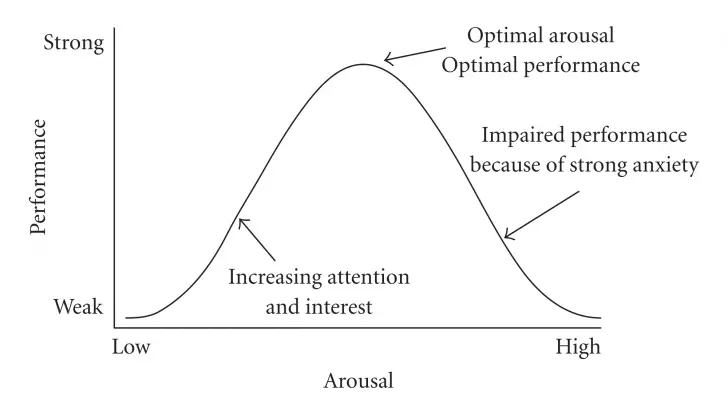The Yerkes – Dodson Law suggests that performance and arousal are directly related. In simpler terms, increase in arousal to a certain level can help to boost performance. Once the arousal crosses the optimal level, performance of the individual starts to diminish.
The law was first proposed by psychologists Robert Yerkes and John Dillingham Dodson in 1908. In their experiment, they discovered that rats could be motivated to complete a maze with slight electrical shocks. But, when the shocks were of the higher degree, their performance level decreased and they just ran about seeking for an escape. It was clear from the experiment that arousal levels helped to focus attention and motivation on the task at hand, but only until an optimum point.
[Related Reading: Arousal Theory of Motivation]
Examples
Example 1
One of the finest examples of this law is the anxiety you face during exam. If your anxiety level is at an optimum balance, then you’ll find yourself performing better by remembering right answers to the question. However, if you’re over anxious you’ll instead feel nervousness and test anxiety, which would then hamper your ability remember the information you specifically learned for the test.
Example 2
Another final example of this law can be taken by looking at the athletic performance of an athlete. A football player hitting a penalty at the last minute of the game can be a nerve wrecking moment for the player. At that instance, if his arousal level is at an ideal level, he will stay composed and scored a goal. However, if he’s too stressed out in the moment, he might instead hit the ball too slow or might not even hit the frame.
Observations
It’s now agreed upon that optimal level of arousal is different for different tasks. Based on our daily activities, some tasks are much simpler to us while others require bit more work. For instance, if we were to take a shower, it’s a task that doesn’t require much attention. So in that sense, it’s a simple task. We could be half asleep and still wash up well. On the other hand, if we were to appear for a test or write a paper on some topic, it would require higher level of attention. Meaning, our optimal level of arousal for complex task, such as writing a paper is higher than the simpler task such as taking shower.
“Some examples of the Yerkes-Dodson law might be helpful. At a track meet, it is almost impossible for sprinters to get too aroused for a race. The task is direct and uncomplicated: Run as fast as you can for a short distance. On the other hand, a basketball player making a game-deciding free throw faces a more sensitive and complex task. Excessive arousal is almost certain to hurt his or her performance.”
(Coon & Mitterer, 2007)
Another example of the Yerkes Dodson law regarding complex and simpler task can be taken, again, in athletic performance. Let’s say, we have a runner and a footballer. A runner’s job is to run and just that, which is pretty uncomplicated for someone who is used to it. So on that note, he wouldn’t require the highest level of arousal. On the other hand, if a footballer was to take the decisive penalty for his team at the 90th minute, he would need to be composed and his arousal level has to be at the optimum level. Excessive arousal or lack of it would definitely hurt his performance.
The Inverted U-Model

Three Levels of Yerkes Dodson Law
Low Arousal Level
The initial stage of the inverted U model (the curve) is low arousal level. it’s mainly associated with lack of sleep, lack of motivation, fatigue, lower body temperature and so on. This is the state of our body when we’re not expecting to perform any complex tasks, or we just have low motivation to do anything. Thus, our attentional mechanisms aren’t really active.
Optinium Arousal Level
Optinium arousal level is the condition of perfect balance where the individual isn’t too aroused neither under aroused, and thus the performance is also optimum for both simple and complex tasks. This is the level of peak shown in the curve. The performance level gradually increases as the curve heads towards the optinium level from the low arousal level, as shown in the graph.
High Arousal Level
This is the state when the arousal level of an individual is over the optimum balance. It’s generally associated with panic, anxiety, lower concentration, physically tensing up, inability to make decisions, over-reacting and so on. Our ability to focus on everything happening in our surrounding diminishes as our tension levels rise up, causing the performance to lower. This level of arousal can be related with, “falling apart under pressure”.
Four Influencers
The inverted U-curve model shown above is only for illustration, the reality however is slightly different from individual to individual depending on the situation.
The influencers that can affect this are
Skill Level
The skill level of an individual also effects his/her performance on the given task. A highly trained individual, confident in his skill, is more likely to cope well in high pressure situations, as the person would be able to rely on his well rehearsed responses.
Personality
Personality of an individual also affects how well he handles pressure. Psychologists believe that extroverts are better at handling pressure than introverts. Likewise, introverts perform better in the lack of pressure.
Trait Anxiety
It’s pretty obvious that a person’s self confidence also affects how he/she handles any situations. If a person’s confidence is high and he/she doesn’t question himself/herself repeatedly over their own abilities, then they are more likely to maintain composure in pressurized situations.
Task Complexity
The level of difficulty of the task is also another factor influencing the performance of an individual. As we have discussed earlier, it would be easier for an individual to take shower in half-sleepy state, but he would need to be in his A game to write an essay. Also, the level of complexity of any task varies from one individual to the next.
Conclusion
After studying the influencers and the U model, it can be concluded that influencers can be placed onto the model either lower or over the optimum arousal level. However, both lower and higher arousal levels can be maintained to the optimum balance.
Self-discipline and professionalism should help avoid performance issues on the left hand side of the graph, the lower arousal level.
Training, improvement of the required skill and experience can help avoid performance issues ont he right hand side of the graph, the higher arousal level.
Note: No matter how hard one tries, even the best of the best can suffer from performance issues when they can’t cope with the pressure, which could occur for variety of reasons.





